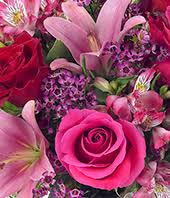
The flowers adorning every bima or aron kodesh I saw this Shavuos, as well as every dining or coffee table of the homes I visited awakened in me a curious (in both senses of the word) thought: It may be pure speculation on my part, but I can’t help but wonder when man began growing flowers simply for their looks and fragrance. Spices are fragrant, true, but their main function is to flavor and preserve food. All other agricultural produce is grown for consumption – whether by humans or their animals. When did people decide to grow lovely plants, like roses, orchids, and daffodils – not for any practical purpose but simply for beauty and olfactory pleasure?
Nowadays, ornamental cabbages are a popular garden addition, planted mainly for their eye appeal, as the more colorful flowers fade in the cold fall months. How did this come to be? Was someone once enjoying a meal and suddenly think to himself, “Hmm, this stuffed cabbage is delicious, but I bet this plant would also look really good in the front yard!”?
Perhaps something like this happened to the rosebush. The International Herb Association designated the rose as the official “herb of the year” in 2012, and apparently, many people use them in recipes, not to mention for medicinal purposes. At the same time, according to Malky Primak of Primak Flowers in Baltimore, “Roses are the most popular type of flower that people order for Shabbos.” I doubt, though, that this is because people are putting them into their cholent. So at what point in time, did roses become very popular simply for their beauty?
A Rose by any Other Name
While regular rose bouquets are within the reach of many a budget, there are some types which you might think twice about before purchasing. In the mountain ranges of Ecuador, near a small town called Machachi, they sell roses that are quite unusual in their height, not to mention price. The stems grow to five feet tall! Twenty-four of these long stemmed beauties will set you back about $730.00. Of course, this does not take into account the cost of any possible renovations your home may need in order to fit them onto the table in your dining room – or the price of a new vase.
The Juliet Rose is known as the “five–million-dollar rose.” Although it isn’t that expensive to purchase, it does seem to run more than double the cost of the more common rose bouquets. The five-million dollars refers to what it cost the breeder, David Austin, to develop it over 15 years.
Rare and Medium Rare
I find dandelions to be very pretty, yet they are maligned as weeds. Is that simply because we don’t plant them? I admit they are rather short stemmed and have a tendency to droop very quickly after “harvesting.” But not all short-lived flowers are viewed as worthless. Some are actually priceless.
Consider the Kadupul flower, native to Sri Lanka, which has a non-existent shelf life. Also called Queen of the Night, it is a type of cactus. You will never be able to display it on your Shabbos table, no matter how much you’re willing to pay – unless your table is located in Sri Lanka and you don’t mind having a very late Kiddush. Even then, you could only see it near your table, assuming it would be kind enough as to choose a Friday night to bloom.
No one has ever been able to harvest a Kadupul, because it cannot be picked without damage. Therefore, you will never find it for sale in any florist shop, including the most upscale. The Kadupul can take up to a year to bloom and then only blooms for a few hours on a single night. Even the native people of Sri Lanka rarely get a glimpse of its blossom. This flower begins to bloom shortly before midnight and then wilts within a few hours. You could call it the quintessential “late bloomer.” I imagine that most people, even if they cultivate this plant, have no idea what day it’s going to bloom. “Honey, do you want to stay up and watch for the flower tonight?”
Speaking of rarity, on the other side of the world is the Gibraltar campion, a flower with pink to pale violet blooms. Only 30 years ago this flower was thought to be extinct. However, in 1994, a single specimen was discovered by a hiker on the cliffs of Gibraltar. Seeds were taken from this single plant and specimens are now grown at the Almeda Gibraltar Botanic Gardens and the Royal Botanic Gardens in London. This is a protected species, so next time you hike on Gilbraltar, be careful where you step.
Orchid Extravaganza
According to scientists, there are over 270,000 types of flowers in existence, of which 25,000 to 30,000 belong to the orchid family. Many orchids are very rare and expensive. (The vanilla orchid, from which vanilla flavoring is derived, is fortunately, not very rare!) One distinctive rare type is known as the Ghost orchid, native to Florida, Cuba, and the Bahamas. One reason it is so rare is that it is almost impossible to propagate. With no leaves, the Ghost orchid does not use photosynthesis to manufacture its own food. It feeds off a specific fungus in close contact with its root system. It can even live underground for years.
The Ghost orchid blossoms in the summer months with 10 flowers, which open one at a time. The fruity fragrance, resembling an apple, is strongest in the early morning hours. Once thought extinct, it is on the threatened and endangered plants list in Florida. If you’re ever in Florida, particularly in the moist, swampy forests, where they hang out, literally, don’t even think about trying to dig this plant up to bring it back with you. It’s illegal. The Ghost orchid has massive roots that attach to a tree, blending in so well that the white flower seems to be suspended in midair: hence, its ghostly name.
Would you spend over $200,000 for a flower? An anonymous buyer paid that price for a Shenzhen Nongke Orchid during an auction in 2005. Shenzhen Nongke is the Chinese corporation that developed this plant in the laboratory over a period of eight years. It takes four or five years for the orchid to blossom. A rare and beautiful plant, it is said to also have a delicate taste, although I have not figured out why someone would eat such an expensive flower.
Another rare orchid is the Gold of Kinabalu. This one seems almost like a bargain at only $6,000 each. The orchid is found only in the Kinabalu National Park in Malaysia. Also very difficult to grow, the blooms can take many years to appear.
Crazy for Tulips
Tulips come in a myriad of vivid shades and make lovely floral arrangements. They are not prohibitively expensive these days, but a few hundred years ago, investors in Holland lost their entire fortunes dealing in tulip bulbs. Although tulips are synonymous with that country, their earliest cultivation was actually done in the Ottoman Empire. The name “tulip” comes from the Persian word for turban. Tulips were first imported into the Netherlands in 1593, where their popularity grew after botanist Carolus Clusius wrote a book about them. Many of the already pricy tulips contracted a non-fatal virus now known as mosaic virus. The virus changed the look of the tulips, causing “flames” of color to appear on the petals. This, in turn, made the bulbs even more in demand for their uniqueness.
By the early 1630s, tulips had become so popular that their value rose to incredible heights. Many people risked their fortunes speculating on tulip prices, creating the first economic bubble, known as “Tulip Mania.” As people bought up rare bulbs, they became so expensive that they were used as currency. Eventually, like other futures markets which followed, the market crashed. At the height of the mania, a tulip bulb could be worth the price of an entire estate. By the end of the crash, they were worth the price of the onion they resemble.
Zinnias Take Flight
Sometimes even commonly found flowers can become uncommon. A case in point is the zinnia. They are not considered very rare – unless you include some “out of this world” zinnia plants. In January 2016, NASA astronaut Scott Kelly shared photographs of the first flowers grown in space aboard the International Space Station. These zinnia plants were part of a science experiment to see how plants would grow in microgravity. The seeds were rooted in NASA’s “Veggie” plant production system” while still on earth, in November 2015. During the nearly three-month flight there was some concern on Scott Kelly’s part that the plants “did not look so good.” At Kelly’s suggestion, the ground team let him take over control of their growth while in flight and allowed him to make his own decisions on how best to care for the zinnias. Ground control’s acquiescence to his request proved successful, and the zinnias bounced back to health. (In microgravity, this may have been literally as well as figuratively.)
Pick your Poison
There are some well known flowers that you definitely should be very careful about before placing them on your Shabbos table, especially if there are precocious children around (not that any of us would know any children who fit that description). I was surprised to find that hydrangeas are actually dangerous if swallowed, particularly since this is a popular flower used as decoration for Shavuos. A few hours after ingestion, they will cause stomach pain. Patients may also experience itchy skin, vomiting, weakness, and sweating. Sometimes even more severe reactions can occur. Fortunately, there is an antidote for hydrangea poisoning as well as other drugs to relieve the symptoms.
The entire Lilly-of-the-Valley plant (also known as Mayflowers) is poisonous. Although eating just a little won’t cause severe symptoms, eating more can result in nausea, vomiting, pain in the mouth, abdominal pain, diarrhea, and cramps. It can also affect the heart rate. Another plant toxic in its entirety is the oleander. Whether ingesting it or inhaling smoke from a burning branch (such as if it is used for roasting marshmallows), it can cause heart rate changes.
Rhododendron and azalea (a variety of rhododendron) bushes have toxic leaves. Honey made from the flower nectar is toxic, too. Symptoms from eating either include a sensation of a burning mouth and increased salivation, vomiting, diarrhea, and a tingling sensation in the skin. Headaches, weak muscles, and dim vision could follow. Heart rate can also be affected by these toxins.
Eating narcissus, also known as daffodils or jonquils, can lead to intestinal discomfort, as well, but generally only if one eats a large quantity of the bulbs, which people sometimes mistake for onions. Children could have a more severe reaction.
Chrysanthemums, also known as mums, are often planted to keep rabbits away. However, the flower heads can also be somewhat toxic to humans, although not usually on a dangerous level. Touching the flowers could cause a slight allergic reaction, causing you to feel itchy or puff up, but this is generally easy to treat with allergy medication.
Calling poison control or your doctor would be appropriate if it is suspected that any of the above flowers may have been ingested.
No matter what types of plants or flowers you display in your home or grow in your garden, it is worth contemplating and appreciating how wondrous and beautiful is the world G-d made for us to enjoy.
An earlier version of this article was published in TACHLIS Magazine.






